Protestors: Cops Initiated Clashes
By Andrea M. Muhammad | Last updated: Sep 29, 2016 - 4:55:13 PMWhat's your opinion on this article?
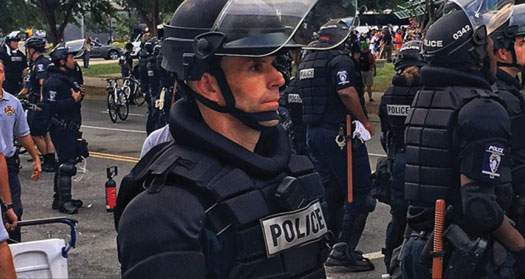
|
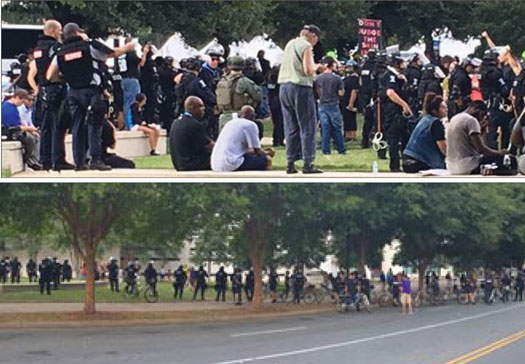
Protesters and police outside of the Carolina Panthers NFL game against the Minnesota Vikings at Bank of America Stadium in Charlotte N.C. on Sept. 25. Photos: MGN Online
|
CHARLOTTE, N.C.—When Gov. Pat McCrory declared a State of Emergency and deployed the National Guard and state highway patrol to restore order after unrest and clashes between the Charlotte Mecklenburg Police Department over the fatal police shooting of Keith Lamont Scott, the governor and officials said the act followed violent protests and looting.
Activists, however, said the clashes were the fault of police officers who inflamed a tense situation and aggressively went after people exercising their right to protest and their right to free speech. The State of Emergency was declared Sept. 21 and was still in effect at Final Call press time Sept. 26, but at midnight to 6 a.m. curfew had been lifted.
Keith Scott was the most recent high profile victim to die in what are officially described as “officer involved shootings.” The 43-year-old husband and father of seven was fatally shot by a Charlotte police officer while waiting at a school bus stop for his son to arrive home.
Mr. Scott’s death sparked outrage across the country and immediate calls for full transparency from the police department. Reaction to the death of Keith Scott produced a groundswell of activism aimed at combating excessive lethal force by police officers and holding them accountable.
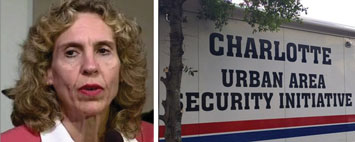
Jennifer Roberts, mayor of Charlotte, North Carolina announced a curfew from midnight to 6 a.m. after 2nd night of violence, Sept. 23.
|
Mr. Romain said no destruction took place until late in the evening and that there would’ve been “no need for any of the destruction. But it didn’t happen until the police took their aggressive tactics toward us.”
Tensions boiled over and protestors started throwing stones and bottles, injuring several officers and damaging police vehicles; a nearby Walmart was looted and traffic was stopped on Interstate 85 after protestors set a fire on the expressway.
The following day, large demonstrations were held in front of police headquarters and at Marshall Park. Again, both gatherings were passionate, yet non-violent diverse gatherings across racial, religious, generational and socio-economic lines. At the conclusion of the Marshall Park rally, demonstrators marched to Little Rock AME Zion Church for a meeting with community and religious leaders. Some remained behind at the church while a majority proceeded to the Epicenter, a complex of restaurants, nightclubs, located in the heart of Uptown, the city’s downtown area.
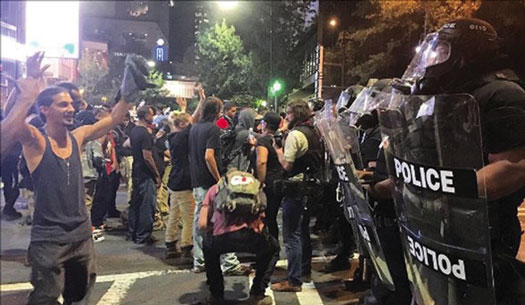
Charlotte, North Carolina. Photo: MGN Online
|
The gathering at the Epicenter turned violent when, once again protestors were met with police dressed in riot gear and the SWAT Team, said demonstrators. Officers crossed behind protestor lines and indiscriminately grabbed protestors deemed “provocateurs,” then dragging demonstrators behind police lines where they were handcuffed and taken into custody. In an effort to stymie protestors, police fired tear gas and sound bombs that only seemed to fuel the defiance of protestors. The angry crowd retaliated by lobbing the tear gas canisters back at police.
Outside the Omni Hotel parking garage, protestors confronted the police. Twenty-six-year-old Justin Carr was shot in the head. Witnesses say they heard a single gunshot. Many scrambled as Mr. Carr fell to the ground bleeding profusely with a gunshot wound to the head. He was taken to the hospital, placed on life support and died the next day. According to police, Mr. Carr was shot by a “civilian protestor.” Again, the police account has been questioned. Some suggested an independent investigation, complete with ballistics testing, should be conducted to rule out whether or not he was shot by the police. Destruction reminiscent of Ferguson and Baltimore broke out as angry crowds shattered windows and looted nearby businesses including the Omni Hotel Charlotte Hornets souvenir shop and the restaurants at the Nascar Hall of Fame.
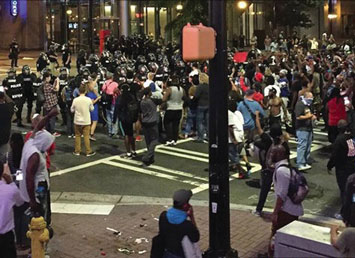
Night two of police protests in Charlotte, North Carolina. Photo: MGN Online
|
The next day, Sept. 22, amid the presence of soldiers from the National Guard and North Carolina state troopers, a cross section of religious leaders walked from Little Rock AME Zion Church to the Omni Hotel for a prayer vigil and to “re-consecrate” the city and site where one protestor was critically injured and later died. During the vigil, a pastor said, “We gather to re-consecrate the grounds of the place we call home, Charlotte. To honor the life of a man whose life was lost here, Justin Carr.” Another pastor prayed, “Lord, we ask for justice now. Justice for the family of Keith Scott. Justice for family of Justin Carr. Justice for all your people.”
Angela English and her 14-year-old twins were at the prayer vigil. “When I found out through Facebook that he (Keith Scott) had been married for over 20 years and he had seven kids, it broke me. It broke my heart. I don’t believe what they (police) are saying. That’s why we need the proof of the video. If we paid for the video, let the public see it, those are my tax dollars. You guys (officials) told us, we’re going to pay for these videos so there would be no issues,” she said.
Her son, Roderick Mitchell Jr. said, “It makes me feel weird how they (police) act. They’re supposed to be here to protect us and they’re not.” Roderick said he trusts some police but not all of them.
Ms. English shared that she did not like the presence of the National Guard in her city. “I am angry. Don’t shine on us because we want to speak out as Black Americans. We want to speak our minds,” she said.
“I knew that I had to make a show of solidarity that Black lives do matter and that this is not just a Black issue, this is an issue for all of us. It’s an issue of inequality and injustice,” said Carol Smith. “Sometimes there has to be something dramatic that takes place in order for people to take notice for change to take place. I’m hoping that, in this tragedy, there does come some recognition of the true need for change that we have in this country. This is endemic of something that is happening all over our country. It’s boiling under the surface and finally, it’s just needing to be released. That’s what we saw last night. It’s not just Black people’s anger. I’m angry about this.”
Ms. Smith gave her take on elected officials’ handling of the crisis. “It makes me very upset that our leadership in their press conference are more concerned about property damage and safety. They did not even address the emotional and all the root causes of what’s happening to cause people to be so upset and angry. Until they acknowledge and want to be open in their dialogue about that, they’re not helping matters at all; they’re just making things worse. There is a militarization effect going on with the police.”
Symona Brayboy moved to Charlotte a year ago. “I’ve seen stuff with my own eyes and know that some cops are too quick to be physical on the citizens. Nobody has the right to just shoot somebody. Even if you have a badge or not, you should try to deescalate the situation,” she said.
After the prayer vigil, demonstrators resumed their protests through the streets of Charlotte for several hours. The interaction between the police, the National Guard took on a more civil tone as demonstrators were allowed to protest without any police escalation.
On Sept. 23, members from Black Lives Matter created a powerful mural outside the Omni Hotel with the names of Justin Carr and many others who died in officer involved shootings. Dianna Blybmbry shared the inspiration behind the compelling piece. “What inspired us to come out here today was the death of Mr. Keith Scott. This is our own protest. It’s written, you can see it, you can feel it. You can’t miss this (the mural), it makes you want to stop and see. We started in front of the courthouse and ended here, in front of where Mr. Justin Carr was murdered,” she said.
Later, protestors reconvened for another night of protest. This time, under police escort, through the streets of uptown Charlotte and parts of Interstate 277, with calls reverberating for Police Chief Kerr to release the body and dash cam videos of the Scott shooting after Mr. Scott’s wife, Rakeyia, released her own cell phone video of the shooting.
Michael Mauney of Charlotte lauded the determination of the demonstrators. “It’s a protest to stand up for the injustice that has been going on for so long. It seems like they don’t want us to speak our voices. They don’t want this to be seen. They don’t want this to be heard. Tonight is our night to be heard, to be seen.”
After watching Mrs. Scott’s video, Mr. Mauney said, “It’s one too many losses of innocent victims, one after another. I feel that the message they are sending is its OK. When you get them live on video, red handed; what more do you need? But (cops) still just walk.” Like many he doubts the police version of what happened to Keith Scott. He believes Chief Kerr Putney should release all the body-cam and dash-cam footage to better enable the public draw its own conclusion.
Mr. Scott was the sixth person in Charlotte to die in an officer involved shooting this year. Once again, the city finds itself in the spotlight of increased scrutiny of law enforcement’s excessive use of “justifiable homicide” incidents with the Black community.
A College Downs resident also blamed police for initial clashes the night of the Scott shooting. “It was a peaceful demonstration, the police were the antagonists,” he said. “None of that (violence) happened until the SWAT team showed up. It was peaceful with just the blue and whites (officers in uniform). All the violence started when the SWAT team showed up and started tear gassing people and throwing those bombs.”
INSIDE STORIES AND REVIEWS
-
-
About Harriett ... and the Negro Hollywood Road Show
By Rabiah Muhammad, Guest Columnist » Full Story -
Skepticism greets Jay-Z, NFL talk of inspiring change
By Bryan 18X Crawford and Richard B. Muhammad The Final Call Newspaper @TheFinalCall » Full Story -
The painful problem of Black girls and suicide
By Charlene Muhammad -National Correspondent- » Full Story -
Exploitation of Innocence - Report: Perceptions, policies hurting Black girls
By Charlene Muhammad -National Correspondent- » Full Story -
Big Ballin: Big ideas fuel a father’s Big Baller Brand and brash business sense
By Bryan Crawford -Contributing Writer- » Full Story






 Click Here Stay Connected!
Click Here Stay Connected!








